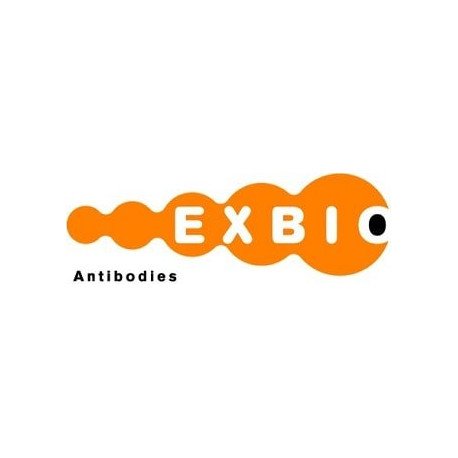Cart 0 Product Products (empty)
No products
To be determined Shipping
0,00 € Total
Prices are tax excluded
Product successfully added to your shopping cart
Quantity
Total
There are 0 items in your cart. There is 1 item in your cart.
Total products (tax excl.)
Total shipping (tax excl.) To be determined
Total (tax excl.)
Data sheet of Mouse Monoclonal to CD59 / Protectin
| Brand | Exbio |
| Product type | Primary antibodies |
| Reactivity | Mouse, Human |
| Clonality | Monoclonal |
More info about Mouse Monoclonal to CD59 / Protectin
| Brand: | Exbio |
| Product no.: | 11-234-C025 |
| Product type: | Primary antibodies |
| Host species: | Mouse |
| Product name: | Mouse Monoclonal to CD59 / Protectin |
| Antigen: | CD59 |
| Clonality: | Monoclonal |
| Clone: | MEM-43/5 |
| Isotype: | IgG2b |
| Immunogen: | Thymocytes and T lymphocytes |
| Format: | purified |
| Specificity: | The antibody MEM-43/5 reacts with well defined epitope (around L33) on CD59 (Protectin), a 18-20 kDa glycosylphosphatidylinositol (GPI)-anchored glycoprotein expressed on all hematopoietic cells; it is widely present on cells in all tissues. _x000D_ The MEM-43/5 does not compete with most other CD59 antibodies. _x000D_ HLDA V; WS Code AS S012 |
| Categories: | CD and Related Antigens & MHC (Rodent), CD and Related Antigens (Human) |
| Concentration: | 1 mg/ml |
| Storage buffer: | Phosphate buffered saline (PBS) with 15 mM sodium azide, approx. pH 7.4 |
| Storage / stability: | Store at 2-8°C. Do not freeze. Do not use after expiration date stamped on vial label. |
| Background: | CD59 (Protectin) is a small (18-20 kDa) GPI-anchored ubiquitously expressed inhibitor of the membrane attack complex (MAC). It is thus the key regulator that preserves the autologous cells from terminal effector mechanism of the complement cascade. CD59 associates with C5b-8 complex and thereby counteracts appropriate formation of cytolytic pore within the plasma membrane. CD59 is also an low-affinity ligand of human CD2 and causes T cell costimulation. |
| Purity: | > 95% (by SDS-PAGE) |
| Purification: | Purified by protein-A affinity chromatography |
| Product specific references: | *Stulnig TM, Berger M, Sigmund T, Stockinger H, Horejsà V, Waldhäusl W: Signal transduction via glycosyl phosphatidylinositol-anchored proteins in T_x000D_ cells is inhibited by lowering cellular cholesterol. J Biol Chem. 1997 Aug 1;272(31):19242-7., *Drbal K, Moertelmaier M, Holzhauser C, Muhammad A, Fuertbauer E, Howorka S, Hinterberger M, Stockinger H, Schütz GJ: Single-molecule microscopy reveals heterogeneous dynamics of lipid raft components upon TCR engagement. Int Immunol. 2007 May;19(5):675-84., *Leukocyte Typing V., Schlossman S. et al. (Eds.), Oxford University Press (1995)., *Bodian DL, Davis SJ, Morgan BP, Rushmere NK: Mutational analysis of the active site and antibody epitopes of the complement-inhibitory glycoprotein, CD59. J Exp Med. 1997 Feb 3;185(3):507-16. _x000D_ |
| General references: | *Baalasubramanian S, Harris CL, Donev RM, Mizuno M, Omidvar N, Song WC, Morgan BP: CD59a is the primary regulator of membrane attack complex assembly in the mouse. J Immunol. 2004 Sep 15;173(6):3684-92._x000D_ _x000D_ , *Menu E, Tsai BC, Bothwell AL, Sims PJ, Bierer BE: CD59 costimulation of T cell activation. CD58 dependence and requirement for glycosylation. J Immunol. 1994 Sep 15;153(6):2444-56._x000D_ _x000D_ , *Rooney IA, Davies A, Griffiths D, Williams JD, Davies M, Meri S, Lachmann PJ, Morgan BP: The complement-inhibiting protein, protectin (CD59 antigen), is present and functionally active on glomerular epithelial cells. Clin Exp Immunol. 1991 Feb;83(2):251-6._x000D_ , *Meri S, Morgan BP, Davies A, Daniels RH, Olavesen MG, Waldmann H, Lachmann PJ: Human protectin (CD59), an 18,000-20,000 MW complement lysis restricting factor, _x000D_ inhibits C5b-8 catalysed insertion of C9 into lipid bilayers. Immunology. 1990 Sep;71(1):1-9._x000D_ |
| Related products: | - Mouse Monoclonal to CD62L (bovine) - Mouse Monoclonal to CD6 - Mouse Monoclonal to CD61 |
| Shipping condition: | Room temperature |


